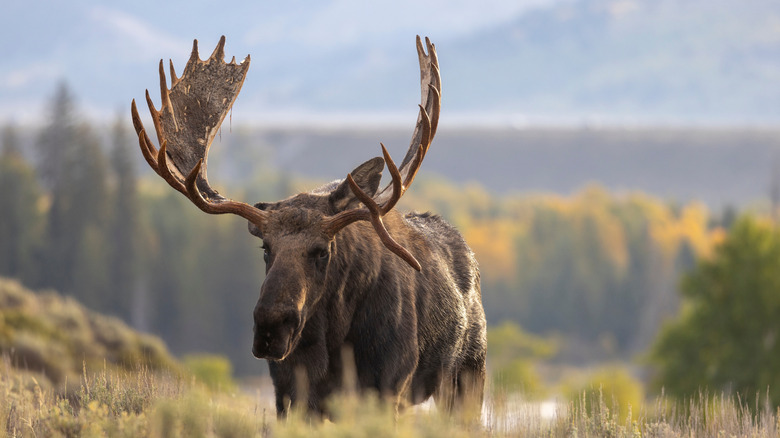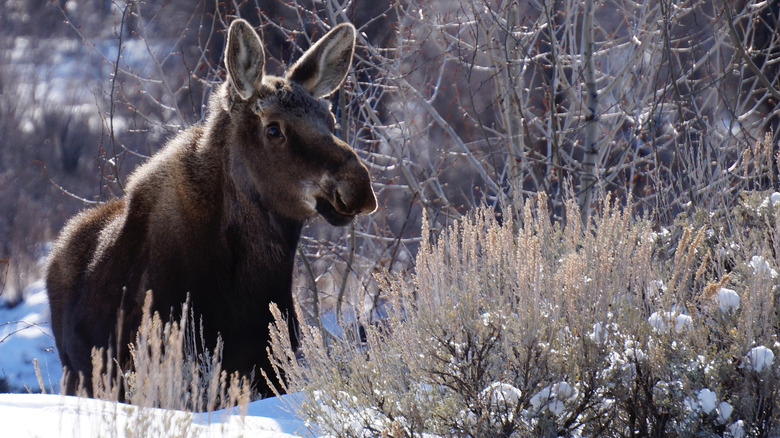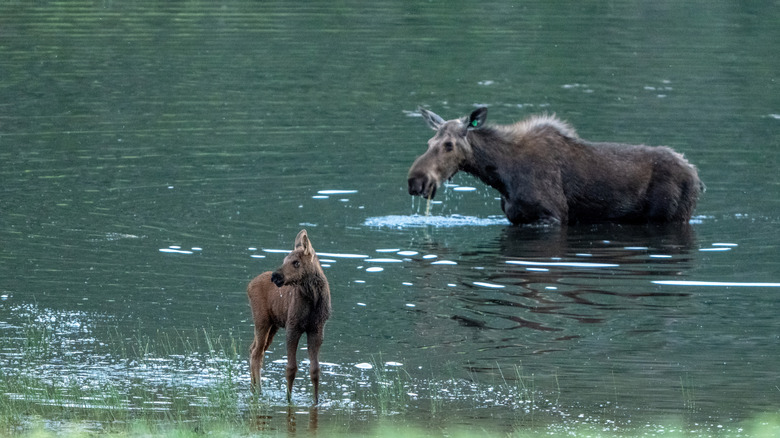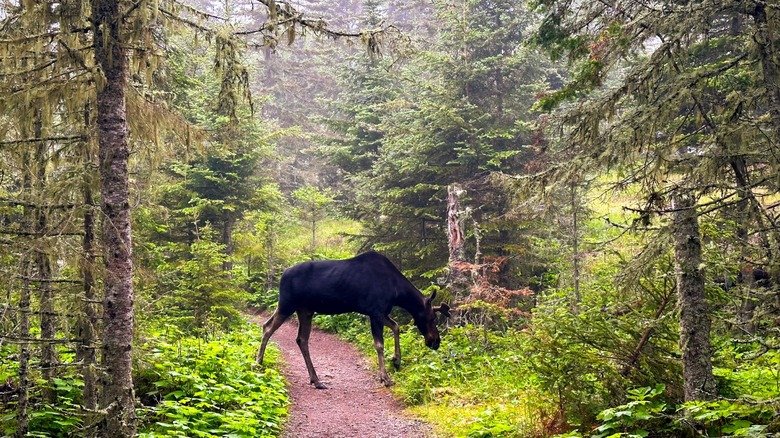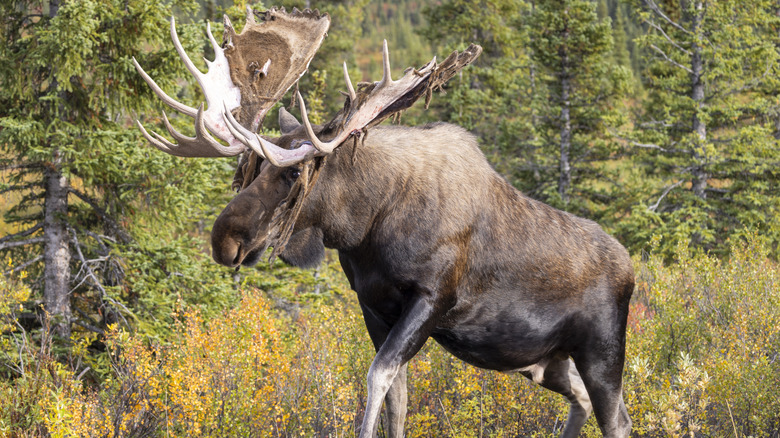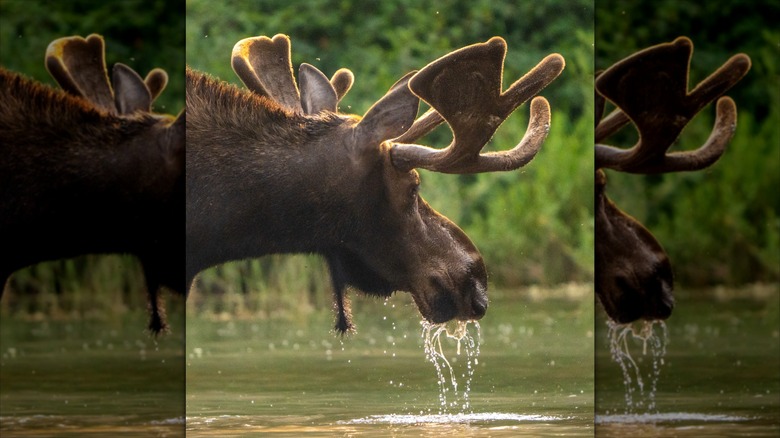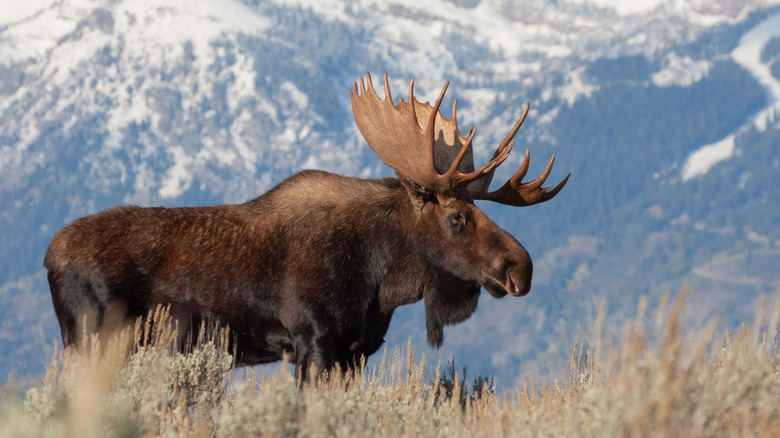The 5 Best Parks To See Wild Moose Roam (That Aren't Yellowstone), According To Research
Wildlife tourism is big business, bringing in millions of dollars as people every year try to get a look at animals in their natural habitats. With their wide swathes of open space, America's national parks are popular places to spot wildlife. And while Mother Nature is made up of all kinds of wonderful animals, big and small, it's the charismatic megafauna that are often the stars of the show. That's the term used to reference large animals that are particularly appealing to the general public.
In the U.S., that includes a variety of animals like humpback whales, wolves, and moose. One popular place to spot moose is in Lamar Valley in Yellowstone, called the "Serengeti of America." But looking at ideal moose habitat along with reports from wildlife experts and park visitors, we know they can be found in more national parks than Yellowstone.
As for why spotting a moose in the wild is so magical, it's at least partly because they can be hard to find. Moose are massive; males can be over 6 feet tall and weigh over half a ton with a set of antlers that are up to 5 feet across. But even with their large size, they are generally solitary, unlike bison, which you can often see in parks in large herds. Moose eat woody vegetation and aquatic plants instead of grasses, and this food is harder to get, so there can't be as many animals in one place. Moose also blend well into a wooded background, making them harder to spot. If you want the best chance of seeing these elusive creatures in the U.S., here are five national parks to try.
Grand Teton National Park in Wyoming
Grand Teton National Park is in northwestern Wyoming, south of Yellowstone National Park. It's a beautiful place to visit with the Grand Teton Range looming large over the valley floor. It's also a sensational place to spot moose. There's even a community called Moose about 7 miles from the Granite Canyon Entrance at the park's southern end. It got its name because you could frequently spot these large mammals there, thanks to the Snake River and the surrounding wetland regions that have the food that moose like to eat.
You can find similar habitats along the Gros Ventre River, making it another good moose-spotting area, with some park visitors noting that the Gros Ventre campground is a notably good place to see them. And if you're looking for moose combined with an iconic view of Grand Teton National Park, Oxbow Bend along the Snake River is an ideal stop. Mount Moran reflects in the river water, making for beautiful photos, and the habitat is great for moose.
Springtime is when you have a higher chance of seeing mothers and babies, as it's when calving season starts, and then in fall, there's the moose rut (aka mating season), which can mean more moose sightings. In winter, you might see them in the sagebrush areas of the park. Moose don't love the heat, and so you are much less likely to see them in the middle of the day in summer, though you might still see them around sunrise and sunset. To help give a boost to your moose sightings, consider going on a wildlife tour with a company, like Jackson Hole EcoTour Adventures or Jackson Hole Wildlife Safaris, rated 5.0 and 4.9 stars on Google, respectively.
Rocky Mountain National Park in Colorado
Rocky Mountain National Park in Colorado has some incredibly beautiful hikes, and it has diverse ecosystems and lots of wildlife, including moose. The history of moose in southern Colorado is interesting because it's still debated. For example, the National Park Service website notes that moose were rare, transient visitors to the area before they were introduced in the 1970s. However, some evidence that suggests there have been moose here for hundreds of years.
Regardless of their history, they're here now, and they're the biggest animal in the park. And one good place to see them is in the Kawuneeche Valley on the west side of the park, near Grand Lake. You can access it via Highway 34, aka Trail Ridge Road, when it crosses through Rocky Mountain National Park, a breathtakingly scenic national park road with or without moose sightings. Timber Creek Campground is also a well-known moose spotting site. Then there's Lulu City, an old mining village, and it's about a 7-mile round-trip hike to get there. Along with seeing a cool, historic site, there's a chance to see moose. An easier hike with moose spotting potential is Sprague Lake, with its wheelchair-accessible 0.7-mile loop trail.
Similar to Grand Teton National Park, if you go early in the day, particularly during summer, that is likely to give you the best time to see moose. Yellow Wood Guiding and Full Potential Wilderness, both rated 5.0 stars on Google, are popular tour companies in the Estes Park area that run wildlife tours.
Isle Royale National Park in Michigan
Isle Royale National Park in Michigan is a remote national park with lots of adventure. It's on an island in Lake Superior, and it's only accessible by seaplane or ferry. Moose have been a part of this out-of-the-way spot for over a century; however, the moose population has had its ups and downs here, literally, topping as many as 2,400 and down to as few as 500. As of 2024, there are around 840 moose, according to Michigan Technological University. The numbers fluctuate on what the moose have to eat and when the moose are food; the only predator for the moose here are the gray wolves, and the moose are the primary food source for the wolves. This predator-prey relationship between the two species is unique and has been studied for decades. Essentially, when there are more wolves, there are fewer moose and vice versa. To learn more about the moose here, Bangsund Cabin in Rock Harbor is the headquarters of the Wolf-Moose Project.
If you're hoping to see these frequently studied ungulates, there are some especially good spots on the park's main island. Washington Creek in Windigo near the ferry dock at the west end of Isle Royale is one such place. The moose like to munch on the plants in the creek here.
The east side of the island, however, is where most of the moose and wolves can be found. Visitors noted on Reddit that moose can often be seen around Rock Harbor, which is at the opposite end of Isle Royale from Windigo. Another good spot where moose like to hang out is Hidden Lake in Tobin Harbor, which is not far from Rock Harbor, and it's also a popular scenic photo spot.
Denali National Park in Alaska
Alaska has the most moose of any state, with around 175,000, and Denali National Park, with the highest peak in North America, has an estimated 1,700 or so of them, according to the National Park Service. They're one of the "Big Five" of the popular mammals in the park, and you may even be essentially greeted by moose when you enter the park since the first dozen or so miles of the Park Road are in prime moose habitat, with moose even hanging out near the visitor center at times. The Riley Creek Campground has had frequent moose sightings, particularly mothers and calves in spring. Make sure to give them a wide berth; a mother moose will aggressively defend her calf if she feels threatened.
Miles 9 to 13 along the Park Road are especially good for bull moose spotting in fall during the rut. You can drive your own car up to Mile 15 of the Park Road. To go further into the park, you have to take a bus, but that means the potential to see more moose. The National Park Service runs narrated bus tours during the summer, with a naturalist who will help you spot wildlife such as moose.
Igloo Creek, at mile 34, can be a good spot, and it has a small tent-only campground. The longer you stay in a place, the more likely you are to see the moose if they're around. Other wildlife you might see at this campground include Dall sheep and bears. Further down the road, Polychrome Overlook at mile 46 is known for moose, along with caribou.
Glacier National Park in Montana
Montana's Glacier National Park is so beautiful, it's known as the "Crown of the Continent." Its natural beauty features streams, forests, lakes, and wetlands with willows, all places that moose like. Glacier National Park is over a million acres in size, and as we know, moose can be hard to spot. So to give yourself a better chance at finding them, visit Fishercap Lake in the Many Glacier region of the park. It's an easy, less-than-a-mile hike to the lake from the Many Glacier Campground, primarily on the Swiftcurrent Pass trail. If you keep going on that trail about a mile or so, you'll get to Red Rock Lake, another well-known moose hangout.
On the west side of the park, Lake McDonald — the largest lake in Glacier National Park — can also attract moose, as can the areas around McDonald Creek as it drains from the lake. National Geographic runs multi-day expeditions in the park that include wildlife spotting, and Glacier Institute runs popular guided single and multi-day tours in summer.
No matter where you see a moose, always keep your distance. If a moose ever changes its behavior due to your presence, you are too close. It's not only for their well-being but for your own — moose can and will charge you, and some warning signs include their ears pressed flat back against their head and their heads lowering. They may look awkward, but they can run fast, up to 35 mph. Appreciate them from a distance and invest in some good binoculars. If you come upon a moose unexpectedly out on the trail, stay calm, back away slowly, and run to get behind a tree if it does happen to charge.
Methodology
Determining which parks gave people the best chance to see moose involved understanding the habitat where they like to live in the U.S., and then checking the National Park Service websites for those more northern parks to see which have noted moose as a frequently seen species. Places like Maine, for example, are well known for having moose; it's even the state animal. But Acadia National Park, Maine's only national park, doesn't have the habitat that moose like.
Travel forums and Google reviews were also referenced to confirm that there were frequent moose sightings in these parks. Finally, parks that had tours and other guided opportunities to help increase the chances of seeing and learning about moose in the wild were highlighted.
